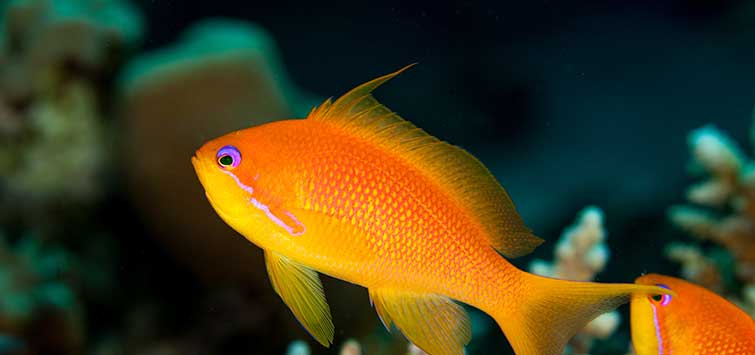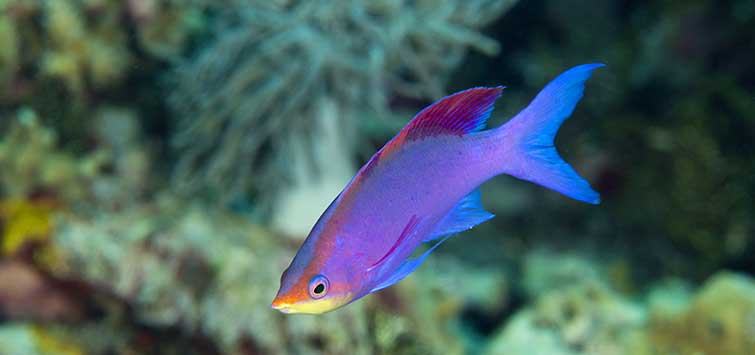Keeping Anthias—School is In!
Joshua Wiegert
One of the most iconic images of marine fish (outside perhaps the classic clownfish nestled in its anemone) is the amazing sight of a huge array of bright, colorful fish swarming over a coral head or shipwreck. These fish, in their multitudes, create an amazing display that many an aquarist would love to replicate in their aquarium.
Often, the fish being photographed or filmed in these impressive schools are not ones we’ll see in aquaria, but rather overgrown bruisers like fusiliers or tuna plying the sea in a large group, or an absolute swarm of smaller fish you’re more likely to find canned in the grocery store than in an aquarium. Or sometimes, even if they are aquarium-keepable fish on an individual level, such as tangs, their incredible intraspecies aggression—especially when confined to a limited space—makes keeping multiples challenging at best and a disaster at worst.
Sometimes, though, the fish in these iconic images are anthias, and a shoal of them makes an incredible display in a sufficiently sized and outfitted aquarium. These beautiful little fish come in a range of colors, and their huge shoals are well known to divers, photographers, and nature documentary watchers. Anthias fish are so iconic and well known that one of the Daughters of Triton in Disney’s Little Mermaid was apparently based upon an anthias. Yet, aquarists often overlook these incredibly beautiful fish.
Scientifically, anthias are members of the same family as groupers, and while that family does include many species better suited to a dinner plate than an aquarium, it also includes a huge number of relatively small, peaceful fish. The subfamily contains about 30 genera and some 200 species, and many of those make it into the trade, too.
Most anthias are small fish, ranging from about 4 to 6 inches (10 to 15 cm), though a couple of species get bigger, with the largest reaching almost 12 inches (30 cm). They’re all brightly colored fish, most displaying colors in the red spectrum, ranging from pink to deep red to orange, though yellow and violet shades aren’t uncommon either. Basically, if you can see it in a sunset, you’ll see it on an anthias.
Schooling and Shoaling
Most anthias are both schooling and shoaling fish. While we typically use the two terms interchangeably, they do have separate technical definitions. A school is a specific type of shoal, and a shoal may contain multiple schools. A shoal is a loose assemblage of fish, usually of the same or similar species, that swim together for mutual protection and/or food-gathering purposes. A school is an organized group of fish, where the members often swim in formations, turning together, swimming in the same direction, etc. Schooling behavior takes energy, and schooling fish often simply shoal unless there’s a reason to school.
While the two terms do have different specific meanings, we’ll generally continue to use them interchangeably beyond noting that most large shoals of anthias fish contain multiple schools. The schools do not often trade individuals, but do swim together and interact in large areas. While the shoal may contain hundreds of individuals, each school is limited to a dozen fish, maybe two dozen on the upper end. Each school will contain typically a single male and a large harem of females.
Among marine fish, sex change is normal, and anthias are no exception. As far as we know, all species of anthias are hermaphrodites, with all fish born females. If there is no male present, the most dominant female in the group will transform into a male. Males are intolerant of one another, and will typically battle one another, which in the confines of the aquarium can be fatal. Females similarly vie for dominance, and they are often harassed by the males as well. Their battles tend to be less aggressive, but a definite pecking order arises among females.
Anthias exhibit strong sexual dichromatism, meaning males and females exhibit very different color patterns. Females are less colorful than males, with the males exhibiting brighter, more complex patterns of color, though—unlike with guppies, for example—the females are not by any means plain, and still colorful in their own right. Since there is often such intense aggression between males, aquarists should be careful to avoid obtaining more than one male. One of the easiest and less expensive ways of doing this is to simply buy nothing but females—in all likelihood, one of the females you obtain will be on her way to becoming a male, or will be shortly, and you’ll soon have a natural order of things sorted out.
The aggression inherent in a school of fish poses several problems for aquarists. Over time, schools often begin to dwindle in individuals, and new fish are seldom accepted into the school. As the pecking order develops and solidifies, fish at the bottom of the chain are often harassed to death, and with each loss, someone else becomes the fish at the bottom of the order. There are several strategies to combat this, many that will be familiar to anyone who has kept freshwater mbuna, cichlids from Lake Malawi that are, in many ways, like a freshwater version of anthias (though they’re not at all related).
Stocking and Keeping
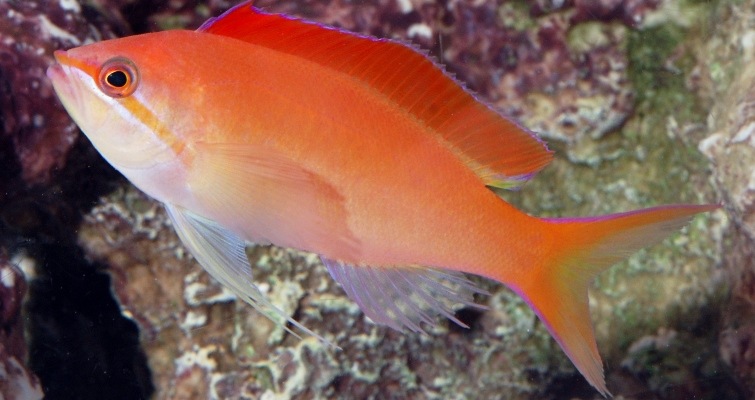
Any aquarium holding anthias should have lots and lots of hiding spots, as well as large objects that break up lines of sight. Fish are kind of dumb—if they can’t see another fish, they assume it’s gone. So, providing a way for a subdominant fish to simply get out of the line of sight of others means it is safe. While holes, caves, nooks, and crannies provide it shelter to escape, unless it can swim out of the dominant fish’s view, it isn’t going to be able to eat. Being driven into a hidey hole every time you try to nab a bit of food is not a recipe for a long, happy life.
Breaking up lines of sight is easy to do in most reef aquariums, but there’s a second piece of advice that’s really difficult for reefkeepers, especially those who (correctly) see a reef tank as primarily for corals, not fish, to wrap their heads around: In order to diffuse the aggression among your group of anthias, add a lot of them.
Maintaining a shoal of 10 to 20 of these fish helps a lot, and I’ve seen tanks where aquarists have gone much, much larger. A large shoal means that no one fish is at the bottom of the pecking order—several are. The aggression is spread out among these fish, and rather than a single fish being picked to death, a bunch of fish are somewhat picked on. This is basically how nature manages aggression in the shoal.
This method should be used with due caution, though. First, your tank must be able to honestly handle this number of fish. Anthias are small, and they produce relatively little waste, but they do add to the bioload of the tank. Second, there is a very real risk that you may introduce a sufficient number of fish for a school to split in two, with two dominant males. Unless your aquarium is gigantic, that would cause some problems.
But the only method that works for introducing new anthias to the tank is to do so in large numbers. Depending on numbers, they may simply form two rival schools that will only shoal if you are also keeping a small shark or something in the tank, but pretty much the only way to add new individuals to the tank is to do so en masse.
The last option to completely avoid the aggression of a school of anthias in your tank is by using the one sure-fire method that guarantees your anthias will not be killed, harassed, stressed, or even bothered by a more dominant anthias: the “keep just one” method. This is also the method that works best for managing aggression in tangs and other similar schooling fish. Anthias, as well as many other marine schooling fish, don’t seem to mind being kept on their own—they aren’t going to stress, hide, and eventually waste away like a single freshwater tetra would. A solo anthias is also going to turn into a dominant male, giving you bright colors.
Feeding Anthias (a Lot!)
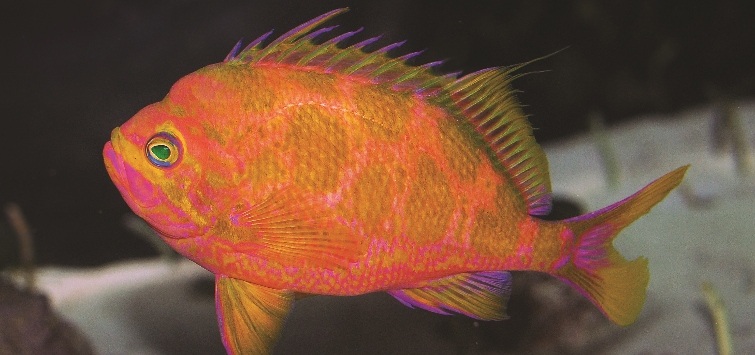
In the wild, anthias fish are active zooplankton predators who basically constantly feed, and from the point of view of a bit of zooplankton, their relation to groupers must seem quite obvious. They have big appetites. This poses what is perhaps the greatest challenge to anthias keepers, more so than managing their aggression. They need to eat many, many small meals each day. Plunking a cube of frozen into the tank once or twice a day is not going to cut it with anthias. They need a small feeding during the day (i.e., when the lights are on) every two or three hours at least.
Indeed, this is a good argument for maintaining a large number of anthias. Anthias feed from the water column, and the food must achieve some sort of particle density for the anthias to find and feed on it. If you drop three pellets in the tank every hour, the anthias aren’t going to find them. So, you’re going to need to put a decent amount of food into the tank each feeding for the fish to find. If there aren’t enough fish to eat it, something else will—bristleworms, aiptasia, or just your nitrifying bacteria. Keeping a bigger group of anthias will ensure that more of the food is winding up where it belongs: in the fish.
You should also consider training your anthias for target feeding. Get them used to getting a squirt of food from a turkey baster or swarming under a feeding station regularly.
Obviously, feeding your fish every single day multiple times a day is not practical for most people. If you’re interested in keeping anthias, regardless of the number, even if it is just a single fish, you’re going to need to invest in a high-quality automatic feeder, and experiment with ones that can take various types of food. While anthias may eat pellets and flakes, they’ll often require a prepared food that more closely resembles their natural diet, such as dried zooplankton. They’ll also need regular supplementation from high quality frozen or liquid suspension foods.
With these excess feedings comes another challenge. While ideally much of this food is winding up in the fish, what goes in must come out, and you’re bound to have some buildup of organic waste in the tank. Heavily skimming your aquarium and performing regular water changes are necessary to maintain water quality—be prepared for both with anthias in the tank.
Which Anthias Is Right for You?
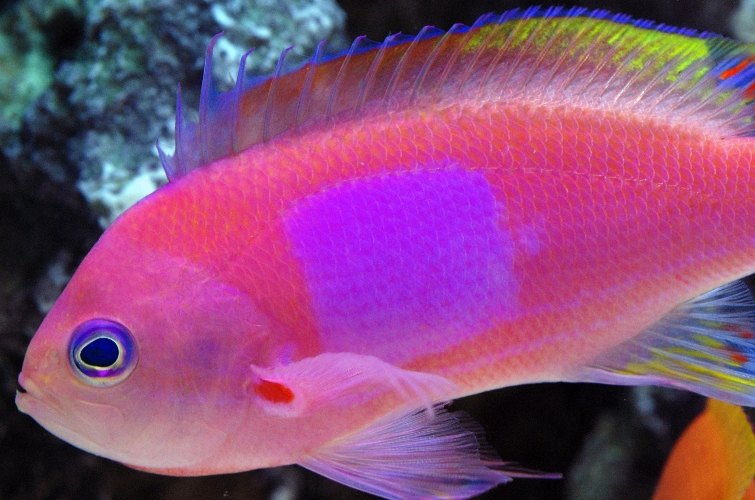
With so many species of anthias, there’s bound to be some differences in both aggression and sensitivity to food. Traditionally, the largest genus of anthias of interest to aquarists was the genus Pseudanthias, which until very recently contained the vast majority of the small aquarium fish. In 2022, the genus experienced a huge reclassification, the effects of which are still being felt; many fish are classified in differing genera depending on which source you use. For that reason, it may be worthwhile further researching these fish using the former genus (Pseudanthias), or even common names.
The best anthias for aquariums, in my opinion, are members of the genus Nemanthias. This genus once contained only a single species, Nemanthias carberryi, which is, in my opinion, the greatest anthias for aquariums, period. It’s joined in that genus now by several similar-looking species, including N. dispar and N. ignitus, which are similar enough to be challenging to tell apart.
In my experience, those three fish tend to exhibit the least interspecies aggression, often being maintained in pairs or trios without issue. They’ll do best when fed several times a day, but I’ve kept them in office tanks that are fed several times a day, five days a week and not at all on weekends, without issue. (I presume they’re picking pods and things like that, too.) The genus also includes N. bartlettorum, which from my observations is among the more aggressive members, though one that’s often available on stock lists.
A new genus erected in the reclassification, Pyronotanthias, contains a handful of species that were formerly known as members of the “lori-complex.” These fishes, like most of the Nemanthias, are relatively peaceful with each other. I’ve found the tiger queen (P. lori) to be comparatively delicate when it comes to feeding, and oftentimes also a very expensive fish. A school of them is doable, but not super affordable.

.png?h=595&iar=0&w=2781&hash=5FD5E69473BCC22199FBFA2FB71B6033)


